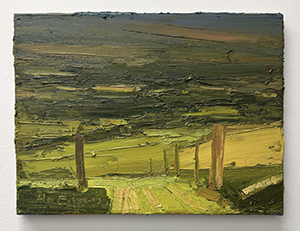Powers|Lowenfels: Crust Sept 3 - Oct 11, 2025 back

Alex Edwards
Rotherley Down Evening Sun II
oil on canvas
14 x 16 in.

Thaddeus Radell
Shroud V
2025
oil on burlap
79 x 24 in.
Alex Edwards’ landscapes exploit, with Abstract-Expressionist zeal, the traditional dramas of the outdoors genre: deep spaces unfolding under an intractable sun.
Hanging opposite, Thaddeus Radell’s paintings build (and rebuild) human faces and figures out of thickly layered paint, each palette-knife stroke suggesting a weighty, primeval struggle.
While Edwards slashes, Radell dollops.
Despite these differences, this two-person exhibition "Crust" at Powers | Lowenfels reveals considerable affinity between their approaches. Both love the physicality of paint and its evocative textures. Both center their work around the internal light that can be generated by artist’s pigments. Both, moreover, know a thing or two about the pictorial potential of color: how shifts in hue, intensity and tone can produce not only volumes and depths, but a momentum of rhythm that resolves broad movements in telling detail. Put another way, for both, color is more than an intriguing effect; it’s a path to a deeper realization.
Edwards painted all fifteen of his landscapes on site near his home base in Dorset, England. Throughout these smallish paintings — only one is wider than 16 inches — the artist’s touch is conspicuous, his brush- and knife-strokes fast and juicy as they lay down angling planes of earth, the rising depths of sky, and occasional punctuation of a fencepost or tree.
Despite its speed of execution, a painting like “North From Monksdown II” feels remarkably complete. In its lower portion, twin slashes of olive green-gray and a buoyant yellow establish the rapid descent to a plain below, where piled, darker horizontals spell out the slow recession, field by field, of the earth’s surface. These slivers of greenish-brown, streaked with cooler hues, fill the painting’s vertical dimension, almost like water filling a pitcher. Sky gleams dimly at the very top, while a few resilient fenceposts in the foreground lend human scale to the proceedings.
Each encounters with nature feels new. With its cloud-dominated sky, “Autumn Evening Rotherley” comes closest to the low-horizon landscapes of such Dutch masters as Jacob Ruysdael. Here, a portion of sky, a brightly elusive yellow, peeks out from below dense mauve clouds filling the painting’s upper half. At the very bottom, the receding groundplane shifts through slices of sunlit and shadowed zones, sounding a complex, panoramic depth.
“Rotherley Down Evening Sun II,” hanging down the wall, offers yet another experience: of distant trees clustering amidst bright, expanding wedges of fields.
Thaddeus Radell’s work falls into two categories: a series of small portraits, each titled “Head Study,” and an installation of five “Shroud” paintings, that, measuring six to seven feet in height, dominate one wall of the gallery. For all of these works, the artist’s oil and wax medium is the trigger point, its turbulent surfaces at once life-giving and encumbering, with clots and veils of pigment fleshing out intimations of features and gestures. The paintings feel at once primitive and cultured, the figures barely emerging, yet fiercely present.
With their thick, knifed-on patches of pigment, the head studies approach the effect of relief sculpture. (Roman Empire medallions come to mind). The most evocative among them may be one of a figure sporting a tawny shirt. Up close, the head seems unsettlingly skull-like in its jabs and pockets of paint. But step back, and colors take over, shaping a likeness out of the shirt’s earthy greens and various glimmering pinks of flesh. Though barely discernible, hints of eyes, nose and mouth spell out the tilt of a face that seems by turns quizzical, knowing and apprehensive. But mostly the head feels unshakably present — a vision coalescing before our gaze, as our own eyes climb from the sturdy breadth of the shoulders to the jaw, then the set of the eyes (evident more as a force than a configuration), and finally the head’s crowning upper contour.
Although they’re painted on rough burlap — left raggedly exposed along the edges — the “Shroud” paintings possess a raw stateliness that distantly recalls, in their hieratic frontalism, the glowing mosaics of Ravenna. The most poignant moments are the most identifiable ones: the sweeping contours of a robe in “Shroud V,” complete with what might be a lowered cowl; the suggestions of the figure’s twisting gesture in “Shroud IV.”
To borrow from Hamlet, we live in a wondrous strange world, and in "Crust" we find two artists remaking its visual aspect in different ways. But both capture their subjects vividly, as only painting can, using its most irreducible ingredients: color, form and texture.
Powers | Lowenfels Gallery
53 Stanton Street, New York NY
10002
917.518.0809 · www.stevenspowers.com
back